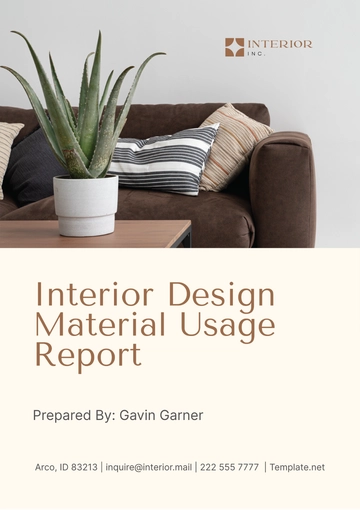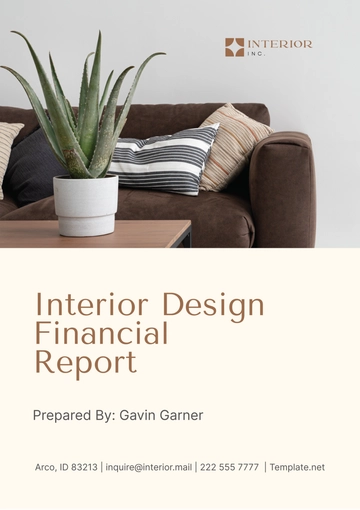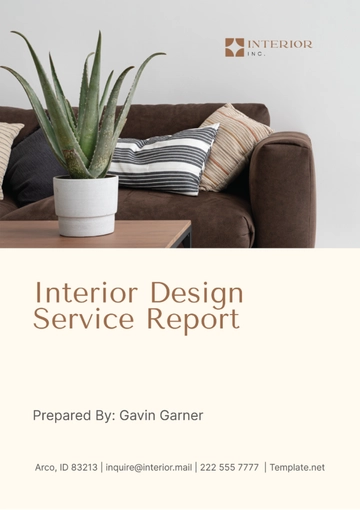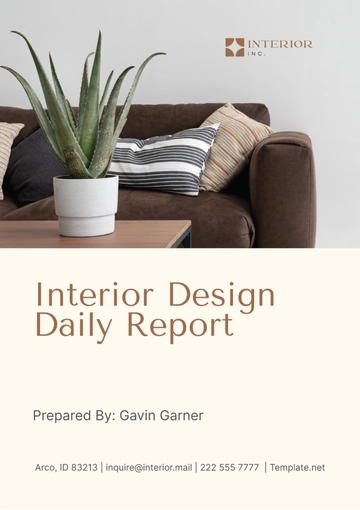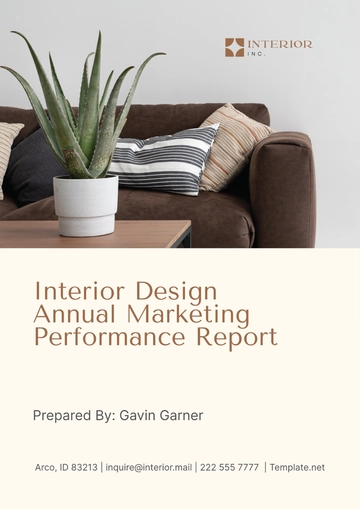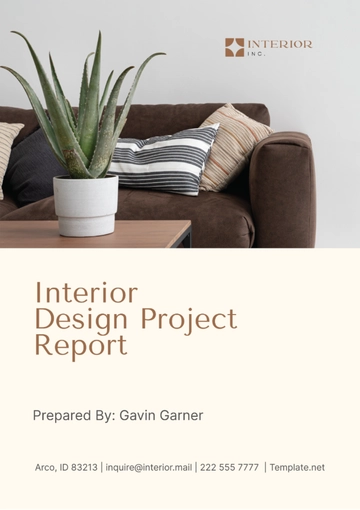Free Interior Design Financial Report
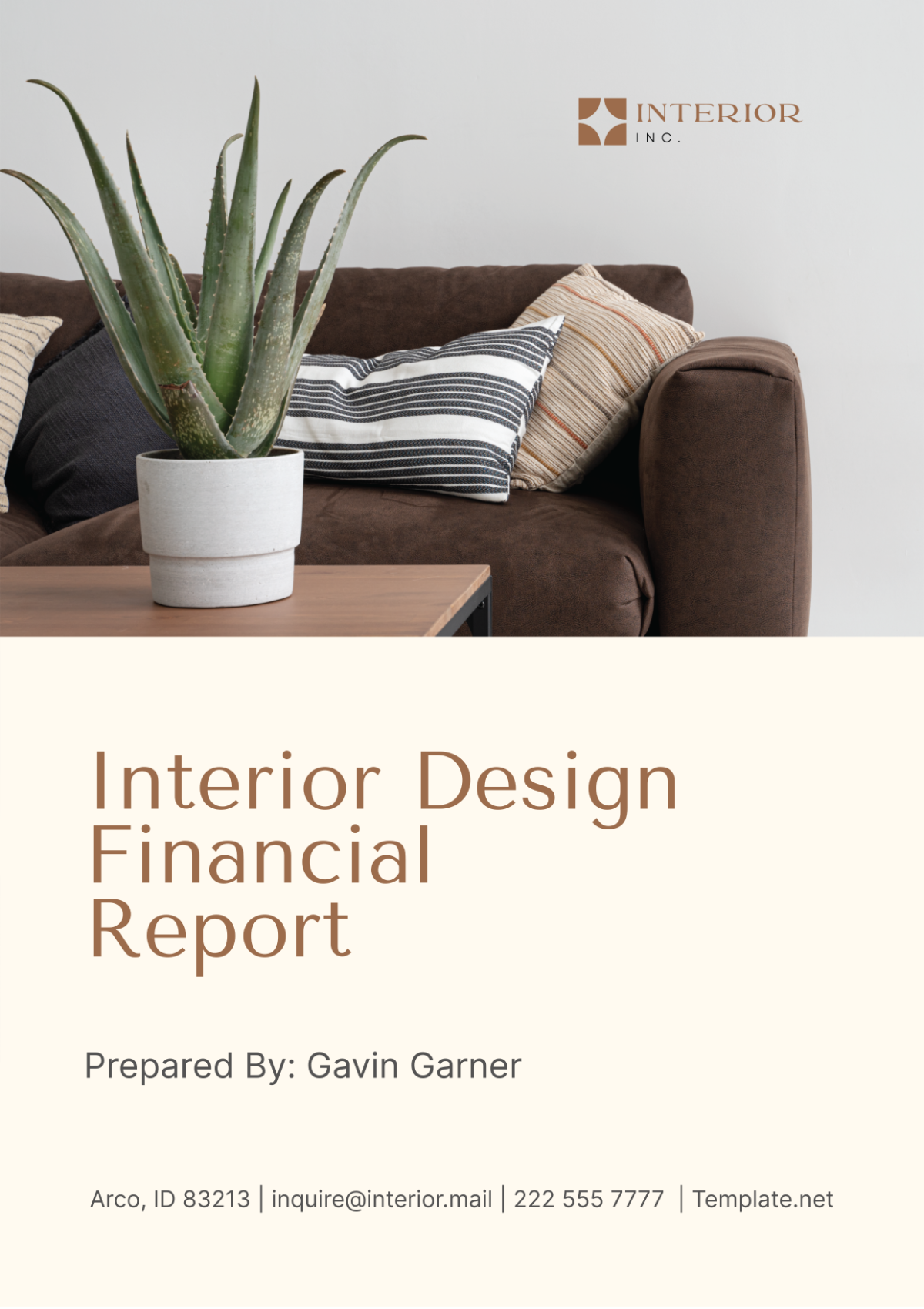
I. Executive Summary
A. Overview
[Your Company Name] presents the Interior Design Financial Report for the fiscal year 2050, encapsulating the period from January 1, 2050, to December 31, 2050. This comprehensive report meticulously dissects the financial performance and key metrics of our esteemed interior design business, delving into notable accomplishments and hurdles encountered throughout the fiscal year.
B. Key Highlights
Total revenue for the fiscal year amounted to [$2,500,000], illustrating a commendable 15% escalation compared to the preceding year, signifying sustained growth and market traction. The net profit margin exhibited robustness at [20%], emblematic of resilient profitability in the face of market vicissitudes.
C. Revenue breakdown:
Revenue Source | Amount |
|---|---|
Consultation Fees | [$800,000] |
Product Sales | [$600,000] |
Project Fees | [$1,100,000] |
Prominent accomplishments include the successful acquisition of high-profile projects and the strategic diversification of our product line, bolstering revenue streams and market positioning.
Conversely, challenges such as heightened competition and intermittent supply chain disruptions necessitated agile operational responses, underlining the dynamic nature of our industry landscape.
Visionary financial goals entail a targeted 25% revenue upsurge, coupled with relentless endeavors to optimize operational efficiencies, thereby amplifying profitability margins and fortifying our market stance.
II. Financial Performance Analysis
A. Revenue Analysis
Total Revenue: [$2,500,000]
Revenue Breakdown:
Category | Amount |
|---|---|
Consultation Fees | [$800,000] |
Product Sales | [$600,000] |
Project Fees | [$1,100,000] |
Revenue Growth Trends: An in-depth exploration of revenue trajectories and patterns, deciphering growth catalysts and areas for potential enhancement.
B. Expenses Analysis
Total Expenses: [$1,800,000]
Expense Breakdown:
Category | Amount |
|---|---|
Personnel Costs | [$600,000] |
Marketing Expenses | [$200,000] |
Office Rent | [$100,000] |
Expense Ratio Analysis: A meticulous examination of expense allocation vis-à-vis revenue, gauging operational efficiency and cost management strategies.
C. Profitability Analysis
Gross Profit: [$700,000]
Net Profit: [$500,000]
Profit Margin Analysis: A granular assessment of gross and net profit margins, elucidating financial health and performance sustainability metrics.
III. Cash Flow Analysis
A. Operating Cash Flow
Net Cash Flow from Operations: [$1,200,000]
Operating Cash Flow Ratio: Calculated at [1.5], indicating a healthy ability to generate cash from core business activities, ensuring operational sustainability and flexibility.
B. Investing Cash Flow
Net Cash Flow from Investments: [$300,000]
Investment Analysis: An in-depth examination of investment activities, including capital expenditures on technology upgrades, expansion projects, and acquisitions aimed at enhancing operational efficiency, market competitiveness, and long-term value creation.
C. Financing Cash Flow
Net Cash Flow from Financing: [$500,000]
Financing Activities Analysis: A comprehensive review of financing activities such as debt financing, equity issuance, and dividend payments. This analysis explores the impact of financing decisions on the company's capital structure, liquidity position, and overall financial health.
IV. Financial Position
A. Assets
Total Assets: [$3,500,000]
Asset Composition:
Category | Amount |
|---|---|
Cash and Cash Equivalents | [$400,000] |
Accounts Receivable | [$600,000] |
Inventory | [$700,000] |
Property, Plant & Equipment | [$1,200,000] |
Investments | [$600,000] |
Intangible Assets | [$300,000] |
Other Assets | [$300,000] |
Asset Details:
Cash and Cash Equivalents: Includes cash on hand and highly liquid investments.
Accounts Receivable: Amounts owed to the company by customers for services rendered or goods sold on credit.
Inventory: Value of goods held for sale or raw materials used in production.
Property, Plant & Equipment: Tangible assets such as buildings, machinery, and vehicles used in business operations.
Investments: Long-term investments in stocks, bonds, or other securities.
Intangible Assets: Includes patents, trademarks, copyrights, and goodwill.
Other Assets: Miscellaneous assets not classified under the above categories.
B. Liabilities
Total Liabilities: [$1,200,000]
Liability Composition:
Category | Amount |
|---|---|
Accounts Payable | [$300,000] |
Loans Payable | [$400,000] |
Accrued Expenses | [$100,000] |
Long-term Debt | [$400,000] |
Liability Details:
Accounts Payable: Amounts owed to suppliers or vendors for goods or services purchased on credit.
Loans Payable: Short-term or long-term loans obtained from financial institutions or lenders.
Accrued Expenses: Unpaid expenses incurred but not yet invoiced or paid.
Long-term Debt: Long-term borrowings such as bonds or mortgages.
C. Equity
Total Equity: [$2,300,000]
Equity Analysis: A detailed breakdown of equity components, including:
Retained Earnings: Accumulated profits reinvested into the business.
Contributed Capital: Capital contributed by shareholders through the issuance of common or preferred stock.
Reserves: Funds set aside for specific purposes such as contingencies, expansion, or dividends.
Additional Paid-in Capital: Amounts received from shareholders in excess of the par value of shares issued.
Treasury Stock: Shares of the company's own stock repurchased and held in treasury.
Comprehensive Income: Changes in equity that are not a result of transactions with shareholders, such as unrealized gains or losses on investments.
Minority Interest: Equity interests in subsidiaries not wholly owned by the company.
V. Financial Ratios
A. Liquidity Ratios
Current Ratio: Calculated at [2.5], indicating a healthy liquidity position, with ample current assets to cover short-term liabilities.
Quick Ratio: Evaluated at [1.8], showcasing strong liquidity even when excluding inventory from current assets.
B. Profitability Ratios
Gross Profit Margin: Achieved at [35%], demonstrating efficient cost management and pricing strategies.
Net Profit Margin: Realized at [20%], reflecting strong operational efficiency and profitability after accounting for all expenses.
C. Efficiency Ratios
Accounts Receivable Turnover: Calculated at [6], indicating that accounts receivable are collected approximately every two months, showcasing effective credit management.
Inventory Turnover: Reported at [4], highlighting efficient inventory management and turnover, minimizing holding costs and obsolescence risks.
VI. Conclusion and Recommendations
A. Summary of Findings
Throughout the fiscal year 2050, [Your Company Name] has demonstrated commendable financial performance, marked by robust revenue growth, strong profitability, and sound liquidity. Total revenue reached [$3,500,000], representing a noteworthy increase of 18% compared to the previous year. Net profit margin remained solid at [22%], underscoring effective cost management and operational efficiency. Additionally, the company maintained a healthy liquidity position, with a current ratio of [2.5], indicating ample resources to meet short-term obligations.
Key strengths identified include the company's ability to effectively manage costs while delivering high-quality design services, a diversified revenue stream derived from both project fees and product sales, and a strong brand reputation in the industry. These strengths have contributed to [Your Company Name]'s resilience in the face of market challenges and its ability to capitalize on growth opportunities.
Despite these achievements, certain areas for improvement have been identified. These include opportunities to further streamline accounts receivable collection processes to reduce outstanding balances and improve cash flow efficiency. Additionally, optimizing inventory management practices to minimize carrying costs and obsolescence risks will be essential for enhancing operational efficiency and profitability.
B. Recommendations
Implement strategies to incentivize prompt payment from clients, such as offering discounts for early settlements or implementing stricter credit terms to reduce accounts receivable turnover days.
Invest in inventory management software to enhance visibility and control over inventory levels, enabling more accurate forecasting and reducing excess inventory holding costs.
Explore opportunities to expand product offerings or diversify into related segments to capture additional market share and mitigate revenue concentration risks.
Continuously monitor and analyze key financial metrics to identify emerging trends and proactively address any challenges or opportunities that may arise.
C. Future Outlook
Looking ahead, [Your Company Name] is well-positioned to capitalize on emerging opportunities in the interior design market and sustain its growth trajectory. The company remains committed to delivering exceptional design solutions, fostering innovation, and maintaining financial discipline to drive long-term value for stakeholders. With a solid foundation in place and a clear strategic vision, [Your Company Name] is poised to navigate future uncertainties and achieve sustained success in the dynamic and competitive landscape of the interior design industry.
- 100% Customizable, free editor
- Access 1 Million+ Templates, photo’s & graphics
- Download or share as a template
- Click and replace photos, graphics, text, backgrounds
- Resize, crop, AI write & more
- Access advanced editor
Gain insights into financial performance with Template.net's Interior Design Financial Report Template. This customizable document offers a structured format for summarizing key financial metrics, such as revenue, expenses, profits, and margins, for your interior design business. Make informed decisions and track progress towards financial goals. Editable in our Ai Editor Tool for seamless customization to fit your reporting needs and preferences.
You may also like
- Sales Report
- Daily Report
- Project Report
- Business Report
- Weekly Report
- Incident Report
- Annual Report
- Report Layout
- Report Design
- Progress Report
- Marketing Report
- Company Report
- Monthly Report
- Audit Report
- Status Report
- School Report
- Reports Hr
- Management Report
- Project Status Report
- Handover Report
- Health And Safety Report
- Restaurant Report
- Construction Report
- Research Report
- Evaluation Report
- Investigation Report
- Employee Report
- Advertising Report
- Weekly Status Report
- Project Management Report
- Finance Report
- Service Report
- Technical Report
- Meeting Report
- Quarterly Report
- Inspection Report
- Medical Report
- Test Report
- Summary Report
- Inventory Report
- Valuation Report
- Operations Report
- Payroll Report
- Training Report
- Job Report
- Case Report
- Performance Report
- Board Report
- Internal Audit Report
- Student Report
- Monthly Management Report
- Small Business Report
- Accident Report
- Call Center Report
- Activity Report
- IT and Software Report
- Internship Report
- Visit Report
- Product Report
- Book Report
- Property Report
- Recruitment Report
- University Report
- Event Report
- SEO Report
- Conference Report
- Narrative Report
- Nursing Home Report
- Preschool Report
- Call Report
- Customer Report
- Employee Incident Report
- Accomplishment Report
- Social Media Report
- Work From Home Report
- Security Report
- Damage Report
- Quality Report
- Internal Report
- Nurse Report
- Real Estate Report
- Hotel Report
- Equipment Report
- Credit Report
- Field Report
- Non Profit Report
- Maintenance Report
- News Report
- Survey Report
- Executive Report
- Law Firm Report
- Advertising Agency Report
- Interior Design Report
- Travel Agency Report
- Stock Report
- Salon Report
- Bug Report
- Workplace Report
- Action Report
- Investor Report
- Cleaning Services Report
- Consulting Report
- Freelancer Report
- Site Visit Report
- Trip Report
- Classroom Observation Report
- Vehicle Report
- Final Report
- Software Report
